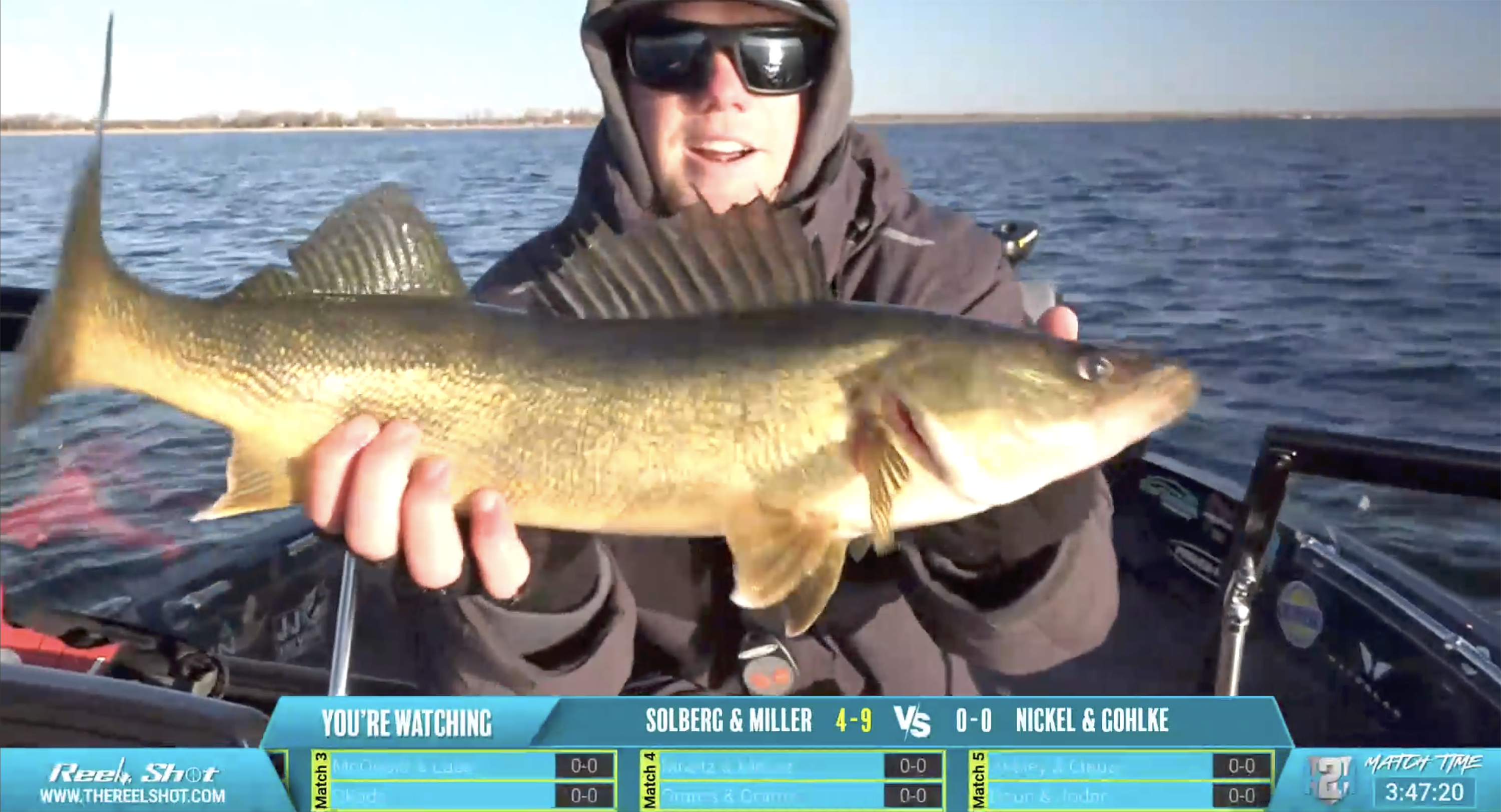news
Working Wing Dams For Walleye with Jarrad Fluekiger
July 27, 2021 8:18 pm
As a child, I remember waking up at the crack of dawn with grandpa tickling my toes and saying, “It’s time to go fishing! Time is a wasting.”

A quick orange and a bowl of Special K from grandma preceded a race to the car to see which grandkid would get there first and earn the right to sit next to grandpa for the ride to the river. Once in the boat, grandpa always seemed to know right where to go and where his next stop was. Grandpa’s magical honey hole always appeared to be a randomly picked spot out in the middle of the river channel!
At least, this is what I thought as a young lad on those earliest fishing trips. These spots were responsible for producing the memories of all the laughs and arguments between my brothers and me. We would laugh from catching tons of fish and argue about who’s casting in who’s spot on the water. Most of the arguments were short-lived as no kid will complain when fish are biting!
It took me a while to figure out the “what and where” of these places Gramps was fishing. We would jump from one side of the channel to the other. I figured it out when I got to be a few years older, and we were fishing wing dams. Man, we caught the walleyes and bass, along with tons of panfish and rough fish. The older I got, the more I wanted to understand these structures and why grandpa always fished them, or more importantly, why he fished some and never fished others.
What are wing dams?
Wing dams are structures that jut out from the shorelines of a river towards the center of the main channel. These structures help force the river flow into the main channel to keep the river deep enough at its center to allow for barge traffic. Wing dams also help stop soil erosion by forcing water away from islands, sandbars, and other structures. Most wing dams are made of rock, but often get covered with sand and submerged trees. Wing dams come in many shapes and sizes. Not all wing dams are created equal. Some wing dams always hold fish, while others are nearly always devoid of life. Studying the location, position, and construction differences of wing dams on the river is something every angler needs to learn. Additionally, the way the river current moves across the surface of a dam can make for a suitable habitat for fish, and identifying this will make you a better wing dam fisherman.

When to study wing dams?
The best way to visually study the characteristics of a wing dam is to do so early in the winter or early spring when water levels are at their lowest. These times are also when water clarity is at its best for the season. Water clarity at this time of year will allow an angler to look at the shallowest portion of the wing dam and see the individual rocks along the top and the front face of the dam. When the ice starts to form on the rocks and sticks out above the water, this gives an angler an easy visual of the high spots on a wing dam. Knowing that will tell you there is a low spot on each side. When the water levels are back up, shallow spots should be a great area to anchor above or troll through. The best way to remember these “spots on the spot” is by taking pictures to reference the following months. Once the waters have risen and hidden these areas from view, you can look back to those particular pieces of structure.



Another critical piece of the puzzle to becoming a proficient wing dam fisherman is to judge the amount of current going over the top of a wing dam accurately. If the river current indicates tolerable conditions, the wing dam may produce more fish. An angler can spend a lot of time and fish all the wing dams in a stretch of the river during the day, but it is easier to build a “feel” for what wing dams are holding fish by observing the water current. This skill to judge river current on a wing dam based on the appearance comes through time spent on the water and LOTS of it. To begin building this skill, pay particular attention to the velocity and appearance of the water in the areas on dams that you are catching fish. What you will find is that fish inhabit a small portion of any given dam. Since river current tends to increase as you move out from shore and towards the tip of the wing dam, you can expect that most wing dams will have one small area with better fishing conditions. Being able to spot these areas quickly saves time and focuses angler’s efforts on high percentage areas.
Which wing dams to start on?
It depends on many factors. River conditions; is it high or low? The time of year; is it spring, winter, summer, or fall?
Spring
Usually, in February and early March, walleyes start to make an annual run-up to the tailwater areas for spawning. At this time, walleyes are still in their wintering holes or on their way out of them. These wintering areas could be anywhere from deep backwater holes to the main channel abysses. Other key areas at this time of year would be side cuts leading to and from the backwaters; Bays off the main channel with at least moderate depth present, a bay off of a backchannel, a deep hole next near to a wing dam, or a small stream or tributary entering the main channel. An angler will find that the wing dams directly above and below these areas are your best producers of quality walleyes if water levels stay stable.


Pulling live bait or cranks on three ways around the face, tip, and backside of the wing dam can be very productive. However, the speed of your presentation is very critical as low water temps dictate slow fishing speeds. My favorite technique is pitching jigs. Throwing hair jigs, Keitech paddle tails, ringworms, or other big plastics are exceptional producers when fished slowly on light jig heads. Both are killer presentations, but you will have to experiment to see what the walleyes will want at that given time regarding color and size of body fished.
Late Spring
Now it is getting into March and April. Water temps and flows are rising, and baitfishes start piling up out of high flow areas. Walleyes still have to find food, so finding wing dams with less current on them will be your go-to spot. I like fishing wing dams that are along a shoreline and spread out over a short distance. Each upstream dam will slow the current for the next one downstream. The last wing dam in the series should yield some quality walleyes during high water conditions. During periods of lower water levels, wing dams upstream in this series of dams will hold the most fish. The faster the current, the closer you will want to be to the shore.
Wing dams located on the INSIDE of bends in the river will have less current than wing dams located in OUTSIDE turns at the same water levels. This fact makes wing dams on the inside turns particularly attractive during the period of high water.
At this time of the year, while the water levels are running high, walleyes will tend to spawn in low-current areas like backwaters, side lakes, streams/rivers, and bays. Once spawning is over, those wing dams near these spawning areas can provide shelter from the high current, and these feeding opportunities will be the ones you will want to target.
May-September
The bite is still in great shape, except now we have to change a few things to stay consistent. Walleyes are starting to spread out over the entire river system, so anglers need to cover more ground to target active fish. Cranking for eyes should be in full swing. Finding funneling areas is a must. I can think of a couple of places that consist of lakes or bays that only have a few outlets from these off-channel areas to the main river. These spots should be a great starting spot. The wing dams next to them are even better. Trolling crankbaits can be an efficient way to locate walleyes around wing dams. Throwing deep diving crankbaits from an anchored position to the “spot on the spot” of a wing dam is often the ticket.
When casting a deep-diving crankbait to a wing dam, I like to throw it on top of the wing dam and slowly reel it back, frequently ticking the dam. In these areas, the current is slack or moving much more slowly than the current nearby. These are the spots to target! Walleyes will use this spot to rest out of the river current while waiting for a potential meal.


Live bait rigging is another good presentation this time of year. There are a couple of ways I like to live-bait rig a wing dam. One way is Dubuque rigging, and the other is the old fashion egg sinker rig. Either way, I fish from an anchored position or a boat on spot lock with my MinnKota Ultrex. The best way to position yourself is to lock down approximately 50′ above the current line or boil line located over the top of the wing dam. 8-10′ upstream from this boil line is the start of the base of the wing dam. The area in front of a wing dam is called the scour hole. You will want your bait in that scour hole as much as possible. When the water hits the face of the wing dam, a back current makes a perfect spot for a walleye to rest and feed – this area should receive the majority of your attention.
On days that walleyes seem finicky, the Dubuque rig and control rigging the face on the wing dam may make all the difference. This way, one can cover all depths of the wing dam and use different presentations. A Dubuque rig uses a three-way swivel and differs from a standard 3-way rig because a jig is used for the needed weight to maintain bottom contact instead of a bell sinker. Doing so provides an angler with additional bait in the water. (Note * This rig is only legal on border waters. Check your local and state regulations.) One side of the three-way is rigged with a plastic body or bucktail on a ¼ – 3/4 ounce jig on a 6-12″ dropper. I use ringworm or paddle tail for most applications. On the other 2′-4′ leader, I typically use live bait with a small floating jig head, plain hook, or combination with various beads for added attraction. Remember, boat control makes all the difference with this technique. Keeping that rig in the strike zone longer will yield more walleyes. I like to use my kicker motor to position my boat above the scour holes when currents are the strongest. Focus on the tips and the depressions at the end of the wing dams when fishing this method.
Fall

Once fall comes around, everyone is usually in the woods hunting. It gets lonely on the river. Why? I haven’t quite figured that out yet! The walleye bite on the wing dams is at its peak in the fall, even surpassing the spring bite for both numbers and the sheer size of fish caught! Crankbaits are working (big ones…#9, #11, #13). Live bait is working. But best of all, the ringworm and the Keitech plastic bite come alive again.
I don’t mean just any ringworm or plastic. I mean big ones. These 4″-8″ size plastics bring strikes that will knock your socks off when a walleye hits. No guessing here because it’s like a freight train hitting the tip of your fishing rod! The best presentation is working that wing dam from the middle out to the point.

Depending on how deep the wing dam point is will determine the size of the jig. During low light conditions, slowly move into the shallows of the wing dam to target the fish that will move from the deeper water. When making this adjustment to the shallower waters, change your jig size to as light as possible.
You will want that jig to drift with the current, presenting your bait in a natural fashion few fish can resist.If your jig comes back to you on a straight line or if you constantly have to lift your rod tip to move your bait up off the bottom, your jig is too heavy.
ActiveTarget™ Live Sonar
Another new piece of the puzzle for wing dams is bringing technology into learning wing dams. ActiveTarget™ Live Sonar sends high-resolution images of fish swimming around wing dams. The Live Sonar shows your lure, as it happens, with the new ActiveTarget™ Live Sonar. It allows you to see the wing dams from a distance with Forwarding, Down, or Scout views. These views let you scan fish locations around your boat and easily track their movements and see features within the wing dam.
These are just a few things to help you become a better wing dam fisherman. Building one’s confidence fishing these structures will pay off in the long run. Remember, there are no wing dams that are identical, and conditions are never the same from one season to the next. Time on the water with close attention to details will provide you with the ability to quickly eliminate unproductive wing dams and zero in on “the spot on the spot” regardless of season or water level.







